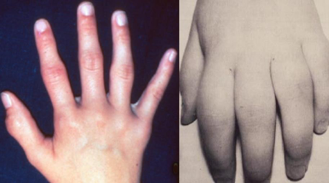Which factor should the nurse include when teaching a parent about the care of a newborn in a Pavlik harness for hip dysplasia?
The harness maintains the hips in flexion, abduction, and external rotation.
The harness may be removed with every diaper change.
The harness is only the first step of treatment.
The harness is worn for 2 weeks.
The Correct Answer is A
A. The harness maintains the hips in flexion, abduction, and external rotation
The factor that the nurse should include when teaching a parent about the care of a newborn
in a Pavlik harness for hip dysplasia is that the harness maintains the hips in flexion,
abduction, and external rotation. The Pavlik harness is a commonly used device for the
treatment of developmental dysplasia of the hip (DDH) in infants. It is designed to hold the
hips in a position that promotes proper alignment and development.
The harness maintains the hips in flexion, abduction and external rotation in (Option B) is
incorrect. The Pavlik harness should not be removed with every diaper change. The harness
needs to be worn consistently as directed by the healthcare provider to ensure the
effectiveness of the treatment.
The harness is the only first step of treatment in (Option C) is incorrect. While the Pavlik
harness is an important step in the treatment of hip dysplasia, it is not the only step.
Additional treatments, such as bracing or surgical interventions, may be required depending
on the severity of the condition.
The harness in worn for 2 weeks in (Option D) is incorrect. The duration for which the Pavlik
harness is worn can vary depending on the individual case and the healthcare provider's
instructions. It is typically worn for several weeks to months, and the specific duration will be
determined by the healthcare provider based on the child's progress and response to
treatment.

Nursing Test Bank
Naxlex Comprehensive Predictor Exams
Related Questions
Correct Answer is A
Explanation
During adolescence, there is a period of rapid physical growth and development. This growth spurt requires additional energy and resources from the body, which can lead to increased fatigue and a heightened need for sleep. The body utilizes sleep as a time for rest, repair, and growth, and during this growth phase, the demand for restorative sleep tends to increase.
decreased activity in (option B) is incorrect because it, does not necessarily contribute to an increased need for sleep. While decreased activity may result in less fatigue and the perception of needing less sleep, it is not a predisposing factor for feeling an increased need for sleep.
typical lack of ambition in (option C) is incorrect because it, is not associated with an increased need for sleep. Lack of ambition refers to a lack of motivation or drive, which is not directly related to the physiological need for sleep.
an inadequate diet in (option D) is incorrect because it, can affect overall health and well- being, but it is not specifically associated with an increased need for sleep. However, a well- balanced and nutritious diet can support healthy growth and development, including adequate sleep patterns.
Correct Answer is B
Explanation
Juvenile arthritis should be suspected in a child who exhibits joint swelling and pain lasting
longer than 6 weeks. Juvenile arthritis refers to a group of chronic inflammatory conditions
that affect the joints in children and adolescents. Persistent joint swelling and pain are
common symptoms of juvenile arthritis and are often accompanied by other signs such as
morning stiffness, limited range of motion, and joint warmth.
, frequent fractures in (option A) is not correct because it, is not typically associated with
juvenile arthritis. Fractures are more commonly associated with conditions affecting bone
strength, such as osteoporosis or certain genetic disorders.
lurching and abnormal gait with limited abduction in (option A) is not correct because it,
may be seen in certain musculoskeletal conditions or hip joint abnormalities, but it is not
specific to juvenile arthritis.
increased joint mobility in (option D) is incorrect because it, is not typically associated with
juvenile arthritis. In fact, joint stiffness and limited range of motion are more characteristic of
this condition.
Whether you are a student looking to ace your exams or a practicing nurse seeking to enhance your expertise , our nursing education contents will empower you with the confidence and competence to make a difference in the lives of patients and become a respected leader in the healthcare field.
Visit Naxlex, invest in your future and unlock endless possibilities with our unparalleled nursing education contents today
Report Wrong Answer on the Current Question
Do you disagree with the answer? If yes, what is your expected answer? Explain.
Kindly be descriptive with the issue you are facing.

